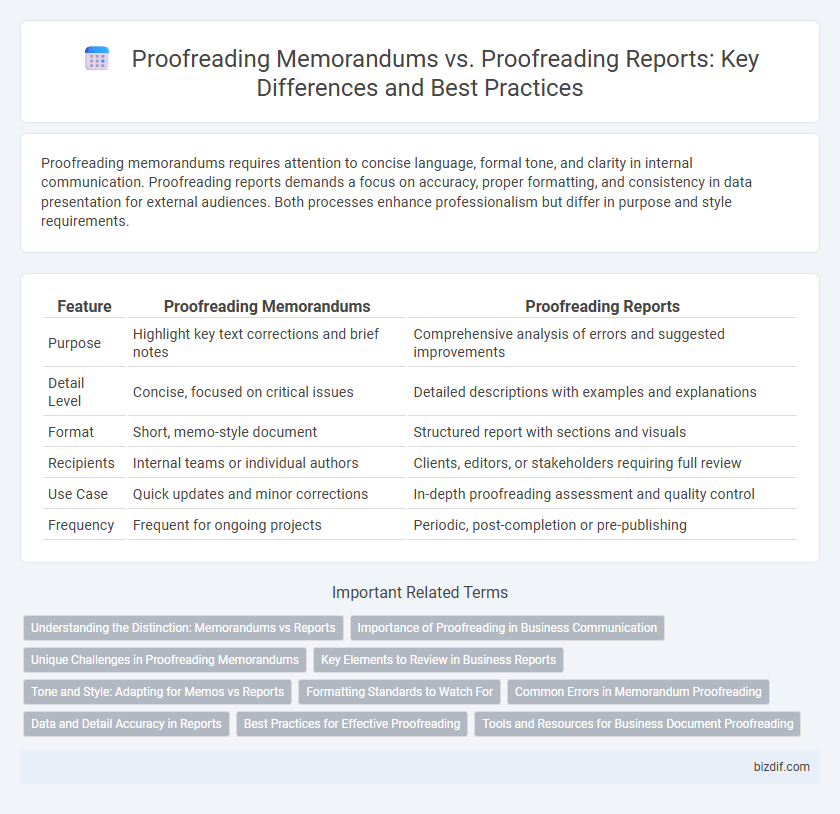Proofreading memorandums requires attention to concise language, formal tone, and clarity in internal communication. Proofreading reports demands a focus on accuracy, proper formatting, and consistency in data presentation for external audiences. Both processes enhance professionalism but differ in purpose and style requirements.
Table of Comparison
| Feature | Proofreading Memorandums | Proofreading Reports |
|---|---|---|
| Purpose | Highlight key text corrections and brief notes | Comprehensive analysis of errors and suggested improvements |
| Detail Level | Concise, focused on critical issues | Detailed descriptions with examples and explanations |
| Format | Short, memo-style document | Structured report with sections and visuals |
| Recipients | Internal teams or individual authors | Clients, editors, or stakeholders requiring full review |
| Use Case | Quick updates and minor corrections | In-depth proofreading assessment and quality control |
| Frequency | Frequent for ongoing projects | Periodic, post-completion or pre-publishing |
Understanding the Distinction: Memorandums vs Reports
Proofreading memorandums emphasizes clarity, conciseness, and formal tone to ensure internal communication is accurate and professional, often addressing specific issues or updates. Proofreading reports requires thorough attention to detail, consistency in data presentation, and adherence to formatting standards to maintain credibility in comprehensive, structured documents. Distinguishing between the two involves recognizing memorandums as brief, targeted communications versus reports as detailed, analytical records requiring meticulous review.
Importance of Proofreading in Business Communication
Proofreading memorandums ensures clarity and professionalism by eliminating errors that can undermine internal communication and decision-making. Proofreading reports is critical for maintaining credibility and accuracy in external business documents, which influence stakeholder trust and strategic outcomes. Consistent proofreading enhances overall business communication by preventing misunderstandings and fostering a polished corporate image.
Unique Challenges in Proofreading Memorandums
Proofreading memorandums presents unique challenges due to their typically concise format and reliance on precise language to convey legal or corporate directives clearly. The proofreader must ensure terminology accuracy and consistency while preserving the document's formal tone and adherence to organizational style guides. Additionally, memorandums often include embedded references or legal citations that require meticulous verification for correctness and relevance.
Key Elements to Review in Business Reports
Proofreading memorandums requires careful attention to clarity, tone, and accuracy in directives and requests, ensuring that the message aligns with the intended business purpose. In contrast, proofreading reports demands a thorough review of data accuracy, logical flow, consistency in formatting, and proper citation of sources to maintain credibility. Key elements to review in business reports include checking numerical data for errors, verifying factual information, and ensuring that headings and subheadings effectively guide the reader through the content.
Tone and Style: Adapting for Memos vs Reports
Proofreading memorandums requires maintaining a concise and formal tone to ensure clarity and professionalism in brief communications, while proofreading reports demands attention to a more detailed and structured style that supports comprehensive analysis. Memos typically use straightforward language and direct sentences, contrasting with reports that often incorporate technical terminology and varied sentence structures to convey in-depth information. Adapting proofreading techniques for each format enhances readability and ensures the document's tone aligns with its intended purpose and audience.
Formatting Standards to Watch For
Proofreading memorandums requires strict adherence to internal formatting standards such as header alignment, font consistency, and margin uniformity, ensuring clarity and professionalism. Reports demand careful attention to section headings, bullet point alignment, and table formatting to maintain readability and logical flow. Both document types emphasize consistent use of style guides like APA or Chicago for citations and references.
Common Errors in Memorandum Proofreading
Common errors in proofreading memorandums include inconsistent use of abbreviations, improper formatting of dates and addresses, and overlooked typographical mistakes that disrupt the document's professional tone. Unlike reports, memorandums often contain informal language errors and unclear subject lines that reduce clarity and impact. Effective proofreading of memorandums requires meticulous attention to style guides specific to internal communication standards.
Data and Detail Accuracy in Reports
Proofreading reports demands exceptional data and detail accuracy due to their formal nature and reliance on precise figures, dates, and technical information. Unlike memorandums, which are often brief and less data-intensive, reports contain extensive datasets, charts, and analysis that require meticulous verification to avoid errors impacting decision-making. Ensuring numerical consistency, factual correctness, and logical coherence in report content enhances credibility and supports organizational accountability.
Best Practices for Effective Proofreading
Proofreading memorandums demand concise clarity and consistency to ensure that key changes and corrections are clearly documented for stakeholders, enhancing accountability. Proofreading reports should emphasize comprehensive feedback and detailed error categorization to facilitate corrective actions and improve overall document quality. Implementing standardized checklists and using specialized proofreading tools are best practices that boost accuracy and efficiency across both memorandum and report formats.
Tools and Resources for Business Document Proofreading
Proofreading memorandums typically leverage specialized tools like Grammarly, Hemingway Editor, and collaborative platforms such as Microsoft Teams to ensure clarity, grammar, and style consistency tailored for internal communications. In contrast, proofreading reports require more robust resources including advanced grammar checkers, formatting software like Adobe Acrobat, and industry-specific style guides to maintain precision and professionalism in formal business documents. Both document types benefit from integrated dictionaries, thesauruses, and version control tools to enhance accuracy and streamline the review process.
Proofreading Memorandums vs Proofreading Reports Infographic

 bizdif.com
bizdif.com